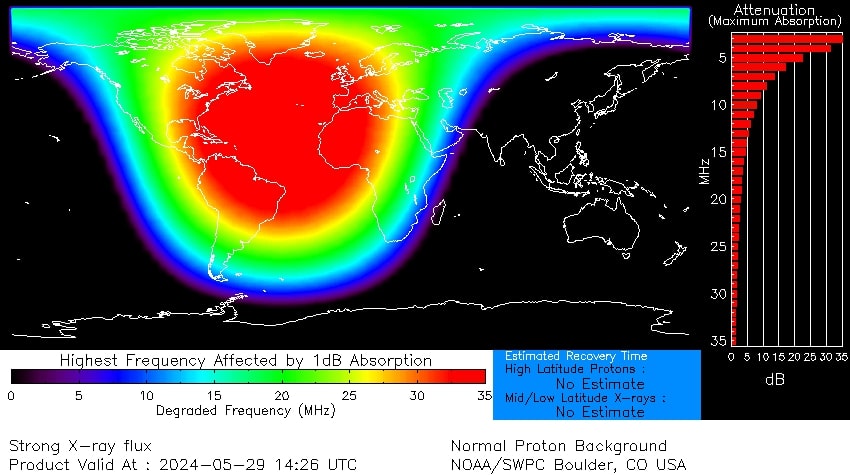Massive sunspot responsible for May's epic auroras unleashes major X-class solar flare (video)
The hyperactive sunspot region doesn't seem to be slowing down anytime soon.
Newly emerged sunspot region AR3697 is already making its presence known, firing off another powerful X-class solar flare as it creeps around from behind the sun's southeastern limb. The solar flare eruption peaked around 10:35 a.m. EDT (1435 GMT), causing shortwave radio blackouts across Western Europe and the Eastern United States.
But this isn't the first time we've encountered the hyperactive behemoth.
Alas, AR3697 is the returned version of sunspot AR3664, responsible for the epic G5 geomagnetic storm we saw a couple of weeks ago — the most powerful solar storm since 2003 that triggered enchanting auroras around the world.

Since then, the sunspot has been rotating around the sun's far side. Now, however, it has officially reappeared on the eastern edge of the sun — and it isn't alone.
There are numerous sunspots currently present on the sun's disk; one notably large and complex one, region AR3691, is also currently facing Earth. According to NOAA's Space Weather Prediction Center, minor to moderate solar flare activity from sunspot regions AR3697 and AR3691 will likely continue from May 29 to May 31. This also raises the chances we're in store for more X-flare activity.
Scientists are keeping a close eye on AR3697, as it is expected to move across the sun's disk and face Earth in the coming days. Such sunspot regions can trigger coronal mass ejections (CMEs), which are eruptions of plasma and magnetic field from the sun. If a CME strikes Earth, it can trigger geomagnetic storm conditions which, in turn, can lead to dynamic aurora displays.
Get the Space.com Newsletter
Breaking space news, the latest updates on rocket launches, skywatching events and more!
However, the potential impact of a CME depends heavily on the location of its source, on the sun — and whether Earth sits in the firing line. The key dates for when the sunspot region will reach its location of optimum Earth connection is around June 4 to June 6, solar astrophysicist Ryan French previously reported for Space.com. "Any significant eruptions during this time have the best odds of producing a geomagnetic storm and enhanced auroras displays here on Earth," French continued.

Shortwave radio blackouts, like the one witnessed over Western Europe and the Eastern U.S. this morning, are common occurrences after powerful solar flare eruptions due to strong pulses of X-rays and extreme ultraviolet radiation emitted during these events. The radiation travels toward Earth at the speed of light and ionizes (gives an electrical charge to) the top of Earth's atmosphere when it reaches us.
This ionization causes a higher-density environment for high-frequency shortwave radio signals to navigate through in order to support communication over long distances. Radio waves that interact with electrons in the ionized layers lose energy due to more frequent collisions, and this can lead to radio signals becoming degraded or completely absorbed.
Join our Space Forums to keep talking space on the latest missions, night sky and more! And if you have a news tip, correction or comment, let us know at: community@space.com.

Daisy Dobrijevic joined Space.com in February 2022 having previously worked for our sister publication All About Space magazine as a staff writer. Before joining us, Daisy completed an editorial internship with the BBC Sky at Night Magazine and worked at the National Space Centre in Leicester, U.K., where she enjoyed communicating space science to the public. In 2021, Daisy completed a PhD in plant physiology and also holds a Master's in Environmental Science, she is currently based in Nottingham, U.K. Daisy is passionate about all things space, with a penchant for solar activity and space weather. She has a strong interest in astrotourism and loves nothing more than a good northern lights chase!









